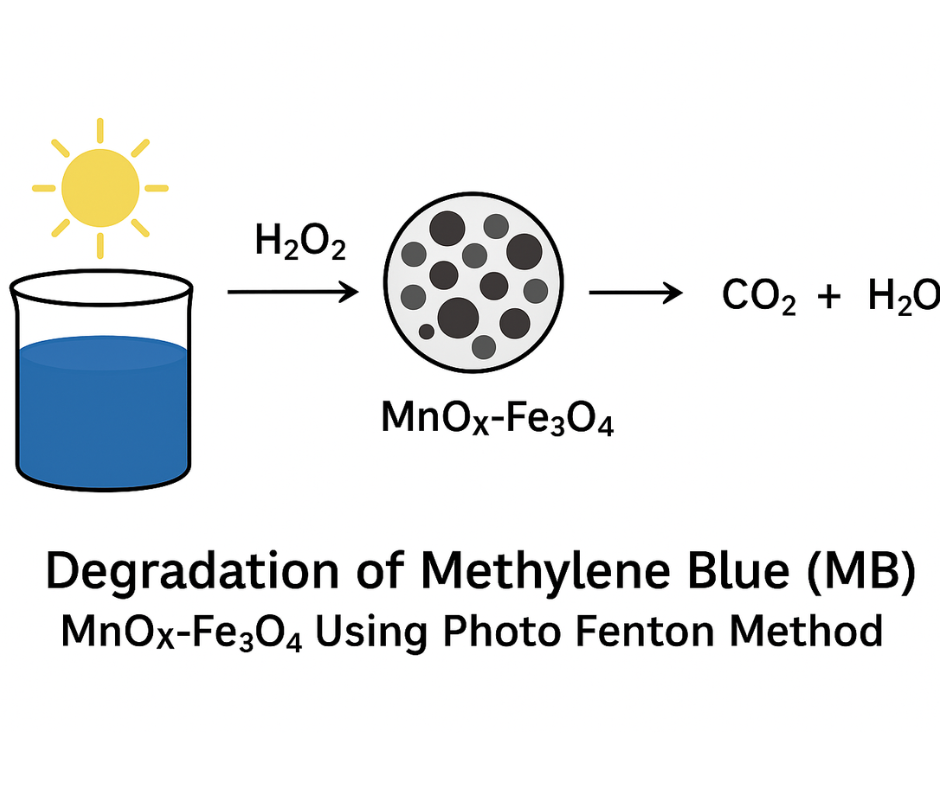
Degrading colour with magnets: degradation of methylene blue MnOx-Fe3O4 using the photo-fenton method
Authors
Aulia Rizki Ramadhanti , Amir Awaluddin , Nurhayati Nurhayati , Sri Hilma SiregarDOI:
10.29303/aca.v8i2.236Published:
2025-11-28Issue:
Vol. 8 No. 2 (2025)Keywords:
MnOx-Fe3O4, fenton heterogeneous catalyst, methylene blue, UV lightArticles
Downloads
How to Cite
Downloads
Metrics
Abstract
One practical approach to reducing methylene blue (MB) levels is through the Advanced Oxidation Processes (AOPs) method, which utilizes hydroxyl radicals (•OH) to degrade the colored compounds. AOPs have proven to be a highly efficient technology in treating coloured wastewater, with the ability to produce strong oxidants that break down molecules that are difficult to decompose naturally. One of the widely used AOP technologies is the Fenton heterogeneous catalyst, which is known for its affordable price, ease of reuse, and the fact that it does not produce solid sludge. In this study, MnOx-Fe3O4 composites were synthesized using the hydrothermal method with variations in the addition of Fe3O4 in ratios of 1:5 and 1:10. Several variables tested in the MB degradation process included the volume of H₂O₂ used (5, 10, and 15 mL), composite contact time, and the effect of pH on degradation efficiency. The results showed that the addition of 5 mL of H₂O₂ to the MnOx-Fe3O4 composite significantly increased the degradation efficiency of methylene blue up to 92.54% within 120 minutes, with an optimal pH of 9. The addition of H₂O₂ was shown to accelerate the degradation process, which shows great potential in wastewater treatment applications. In addition, the magnetic properties of the MnOx-Fe3O4 composite allow easy separation of the catalyst after the treatment process, thus accelerating and facilitating the recovery and reuse of the catalyst. This degradation process involves the formation of hydroxyl radicals (•OH), which are highly reactive and can efficiently break down MB molecules. Thus, this study demonstrates that the MnOx-Fe3O4 composite has the potential to be a highly efficient and environmentally friendly catalyst for treating coloured wastewater. This catalyst is also expected to be reusable in several cycles, making it a sustainable and effective choice in industrial wastewater treatment.
References
Anggraini, R., Siregar, S. S., Awaluddin, A., & Linggawati, A. (2021). The preliminary studies on the tremendous degradation rate of methylene blue with Cu-doped α-MnO₂ photocatalyst under UV light irradiation. A Journal of Physics Conference Series, 1(1), 1–8.
Nasaruddin, R. R. (2021). A systematic literature review on the effects of synthesis conditions to the physicochemical properties of activated carbons and their performance in methylene blue adsorption. Malaysian Catalysis-An International Journal, 1, 12-30..
Budiman, S., Sanjaya, H., Isnaeni, I., Nizar, U. K., & Nasra, E. (2022). Degradasi metilen biru secara fotolisis dengan katalis Cdots doping Au. Jurnal Periodik Jurusan Kimia UNP, 11(3), 18–25.
Suprihatin, I. E., Suat, R. M., & Negara, I. M. S. (2022). Fotodegradasi zat warna methylene blue dengan sinar UV dan fotokatalis nanopartikel perak. Jurnal Kimia, 16(8), 1–10.
Susanti, I., & Santoso, A. (2020). Efektivitas lempung alam dan kulit pisang sebagai bahan komposit untuk adsorpsi metilen biru. Jurnal Sains Terapan Kimia, 5(2), 258–260.
Rosanti, A. D., Wardani, A. R. K., & Latifah, E. U. (2020). Pengaruh variasi konsentrasi urea terhadap fotoaktivitas material fotokatalis N/TiO₂ untuk penjernihan limbah batik tenun ikat Kediri. Jurnal Kimia Riset, 5(1), 55–63.
Agnestisia, R. (2017). Synthesis and characterization of magnetite (Fe₃O₄) and its applications as adsorbent for methylene blue. Jurnal Sains dan Terapan Kimia, 11(2), 61–67.
Li, Z., Tang, X., Liu, K., Huang, J., Xu, Y., Peng, Q., & Ao, M. (2018). Synthesis of a MnO₂/Fe₃O₄/diatomite nanocomposite as an efficient heterogeneous Fenton-like catalyst for methylene blue degradation. Beilstein Journal of Nanotechnology, 9(1), 1940–1950.
He, Y. (2018). Synthesis of MnO₂ nanosheets on montmorillonite for oxidative degradation and adsorption of methylene blue. Journal of Colloid and Interface Science, 510, 207–220.
Dubey, M., Challagulla, N. V., & Kumar, R. (2022). Synergistic engineering for adsorption-assisted photodegradation of 2,4-dichlorophenol using easily recoverable α-MnO₂/Fe₃O₄ nanocomposite. Applied Surface Science Advances, 11, 100030.
Ghasemi, H., Mozaffari, S., & Mousavi, S. (2021). Decolorization of wastewater by heterogeneous Fenton reaction using MnO₂–Fe₃O₄/CuO hybrid catalysts. Journal of Environmental Chemical Engineering, 9(2), 105091.
Chen, Z., et al. (2019). Magnetic Mn-doped Fe₃O₄ hollow microsphere/RGO heterogeneous photo-Fenton catalyst for high-efficiency degradation of organic pollutants at neutral pH. Materials Chemistry and Physics, 238, 121893.
Siregar, S. S., & Awaluddin, A. (2018). Synthesis and catalytic activity of birnessite-type manganese oxide synthesized by solvent-free method. IOP Conference Series: Materials Science and Engineering, 345, 012005.
Awaluddin, A., Agustina, M., Aulia, R. R., & Muhdarina. (2017). Precursor effects on the morphology and crystallinity of manganese oxides and their catalytic application for methylene blue degradation. AIP Conference Proceedings, 1823, 020108.
Awaluddin, A., Zulfa, R., Absus, S., Nurhayati, N., Linggawati, A., & Siregar, S. S. (2019). The enhanced catalytic activities of octahedral layer birnessite-type manganese oxide synthesized via precipitation method for the degradation of methylene blue. IOP Conference Series: Materials Science and Engineering, 509, 012011.
Zulfa, R., Absus, S., Awaluddin, A., Anita, S., Siregar, S. S., & Zulfikri. (2018). Effect of precursors on morphology and catalytic activities of birnessite for methylene blue degradation. Journal of Physics: Conference Series, 1097(1), 012051.*
Sandani, Y., Nurhayati, N., Amirudin, E., Anggraini, R., Siregar, S. S., & Awaluddin, A. (2021). The effect of hydrogen peroxide on catalytic activity of manganosite MnO/oil palm fly ash catalyst for methylene blue degradation. Journal of Physics: Conference Series, 2049(1), 012038.
Dini, E. W., & Wardani, S. (2014). Degradasi metilen biru menggunakan fotokatalis ZnO–zeolit. Chemical Progress, 7(1), 1–6.
License
Copyright (c) 2025 Aulia Rizki Ramadhanti, Amir Awaluddin, Nurhayati Nurhayati, Sri Hilma Siregar

This work is licensed under a Creative Commons Attribution-NonCommercial-ShareAlike 4.0 International License.
Authors who publish with ACA: Acta Chimica Asiana agree to the following terms:
- Authors retain copyright and grant the journal right of first publication with the work simultaneously licensed under a Creative Commons Attribution-NonCommercial-ShareAlike 4.0 International License. This license allows authors to use all articles, data sets, graphics, and appendices in data mining applications, search engines, web sites, blogs, and other platforms by providing an appropriate reference. The journal allows the author(s) to hold the copyright without restrictions and will retain publishing rights without restrictions.
- Authors are able to enter into separate, additional contractual arrangements for the non-exclusive distribution of the journal's published version of the work (e.g., post it to an institutional repository or publish it in a book), with an acknowledgement of its initial publication in ACA: Acta Chimica Asiana.
- Authors are permitted and encouraged to post their work online (e.g., in institutional repositories or on their website) prior to and during the submission process, as it can lead to productive exchanges, as well as earlier and greater citation of published work (See The Effect of Open Access).





 Indonesian Chemical Society, Chapter Nusa Tenggara. Jalan Majapahit 62 Mataram, University of Mataram, 83125, Indonesia
Indonesian Chemical Society, Chapter Nusa Tenggara. Jalan Majapahit 62 Mataram, University of Mataram, 83125, Indonesia





